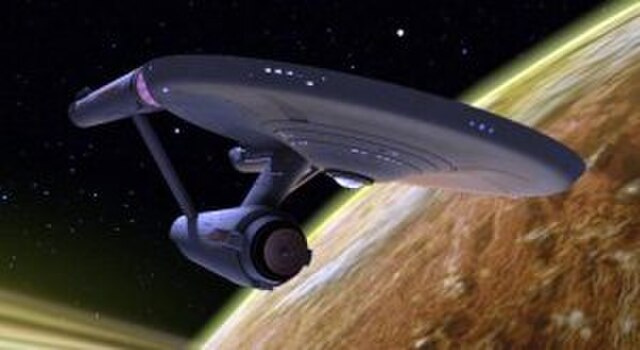The Star Trek franchise features many spacecraft. Various space vessels make up the primary settings of the Star Trek television series, films, and expanded universe; others help advance the franchise's stories. Throughout the franchise's production, spacecraft have been depicted by numerous physical and computer-generated models. Producers worked to balance often tight budgets with the need to depict convincing, futuristic vessels.
Matt Jefferies' design of the USS Enterprise—featuring a saucer section, engineering hull, and external engine nacelles—established a design schema that influenced the Star Trek franchise's future television and film spin-offs.
The original series' Klingon cruiser design was retained for the first Star Trek film, and the motif of a manta ray-type hull with a bulbous prow influenced the design of Klingon vessels in subsequent films and spin-offs.
Industrial Light & Magic's William George based his USS Excelsior design on what he thought the Enterprise would look like if it were designed by the Japanese. The model retains the distinct hull features of Matt Jefferies' Enterprise. Redresses of the Excelsior model, and later digital versions, were heavily used throughout the franchise.
Star Trek Generations (1994) mainly features one of the original Enterprise-D models Industrial Light & Magic created for Star Trek: The Next Generation (1987–1994). The model was rewired and resurfaced for film presentation. Although a more-detailed Enterprise model was created midway through The Next Generation's run, one of the originals was used for the film because it was the only one capable of depicting the saucer section's (foreground) separation from the engineering hull.
Star Trek III: The Search for Spock
Star Trek III: The Search for Spock is a 1984 American science fiction film, written and produced by Harve Bennett, directed by Leonard Nimoy, and based on the television series Star Trek. It is the third film in the Star Trek franchise and is the second part of a three-film story arc that begins with Star Trek II: The Wrath of Khan (1982) and concludes with Star Trek IV: The Voyage Home (1986). After the death of Spock (Nimoy), the crew of the USS Enterprise return to Earth. When James T. Kirk learns that Spock's spirit, or katra, is held in the mind of Dr. Leonard "Bones" McCoy, Kirk and company steal the decommissioned USS Enterprise to return Spock's body to his homeworld. The crew must also contend with hostile Klingons, led by Kruge, who are bent on stealing the secrets of the powerful terraforming device, Genesis.
Visual supervisor Ken Ralston (far right) worked with Paramount early in production to develop plans for The Search for Spock's effects.
The Search for Spock continues The Wrath of Khan's exploration of Christian biblical themes of life, death, and rebirth.






